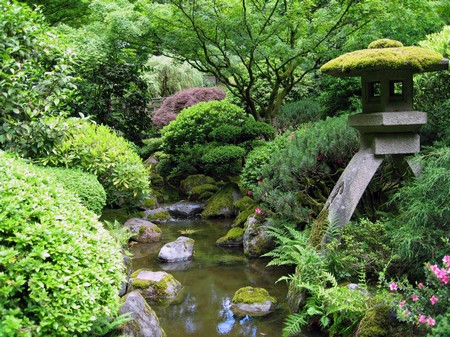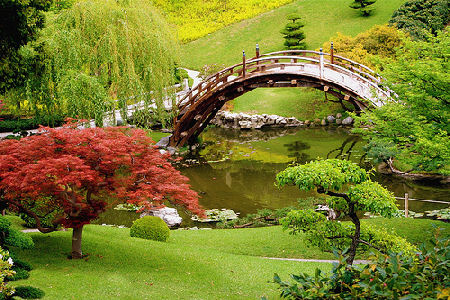There are few styles of garden more clinical yet as serene and calming as Japanese gardens. These gardens traditionally make extensive use of water, stone lanterns, bamboos, maples, azaleas, bridges and pagodas, but a simpler form can be created for small, enclosed gardens.
This is the so-called ‘dry garden’, a replica Japanese garden in which raked coarse sand or fine gravel covers the entire area and represents water, with rocks carefully positioned to create land. Additionally, distinctive plants in containers can be strategically placed to form focal points or areas of interest near paths or buildings. Shrubs and small trees can also be planted in soil at the edges, with sand raked around them. Specimens of bonsai, the ancient Japanese art of miniature plant-growing, can be displayed on low tables. Bonsai shrubs and trees are grown in small, shallow containers and kept ‘dwarf through regular pruning of their leaves, stems and roots.
Construction and maintenance
Small ‘dry’ gardens are easy to plan and quick to build, but sometimes they suffer from problems with weeds. When preparing the area allocated for your dry garden, remove all perennial weeds, such as docks, dandelions, couch grass and ground elder. Rake and firm the surface, then place a porous fabric or plastic sheet over the entire area. Next, place a thin layer of fine gravel or coarse sand over the top. The surface of your Japanese garden needs to be raked regularly to create patterns in the gravel or sand and to remove debris, such as fallen leaves. Use a metal garden rake to create patterns. In ancient Japanese gardening, alternating rows of straight and wavy lines represent the flowing of a stream, while circles raked around rocks accentuate the fact that they look like islands.
Plants for dry garden containers
- Acerpalmatum ‘Dissectum Atropurpureum’: Forms a low, dome-headed deciduous tree with finely-cut, bronze-red leaves. A. p. ‘Dissectum’ is similar, with light green leaves. Both these small trees are ideal for planting in large tubs, or even in the ground with gravel drawn around them. Height: 60-75cm Spread: 1.2m
- Fargesianitida (previously known as Arundinaria nitida): Hardy bamboo with purple stems that reveal a waxy bloom and bear bright green leaves. It is ideal for planting in a large, wooden planter. Height: 1.8-2.4m Spread: Forms a clump
- Fargesia murieliae (previously known as Arundinaria murieliae): Hardy bamboo with arching canes bearing dark green, narrowly lance-shaped leaves. It is ideal for planting in a large, square, wooden planter. Height: 1.8-2.lm Spread: Forms a clump Picea glauca ‘Alberta Blue’: Evergreen conifer, forming a dense pyramid of silvery-blue foliage. Height: 45-60cm Spread: 30-45cm
- Pinusmugo ‘Ophir’: Evergreen conifer with a compact, rounded nature formed of dark green, gold-tipped needles that turn bright gold during winter. Height: 60cm (2ft) Spread: 75-90cm
- Pinusstrobus ‘Radiata’ (previously known as P.s. ‘Nana’): Distinctive, slow-growing, evergreen conifer with a dignified appearance formed by dark, blue-green needles. Height: 75-90cm Spread: 1.2-1.5m
- Sasaveitchii: Hardy bamboo with large, green leaves with papery, white edges. It is ideal for planting in a large, wooden planter. Height: 1.2-1.5m Spread: Clump-forming
Tea gardens
A tea garden was traditionally important in the ritual of Japanese tea ceremonies – an area where people would assemble and cast off worldly cares before drinking tea. The garden’s purpose was to encourage serenity and to focus thoughts. The garden was uncomplicated by ephemeral flowers; instead, trees, shrubs and ferns created a timeless and serendipitous landscape. The dry garden described opposite emulates this area of the Japanese garden.
Categories
Advertisements
Recent Articles
 How to Understand Bed Sizes – A Small Guide
How to Understand Bed Sizes – A Small Guide How to Select Some Must Have Kitchen Accessories
How to Select Some Must Have Kitchen Accessories Best Way to Change a Car Tire
Best Way to Change a Car Tire Best Way to Write an Affirmation
Best Way to Write an Affirmation Best Way to Take Charge of Your Financial Life
Best Way to Take Charge of Your Financial Life Best Way to Survive a Party When You Don’t Know Anyone
Best Way to Survive a Party When You Don’t Know Anyone Best Way to Stop Self Sabotaging Yourself
Best Way to Stop Self Sabotaging Yourself Best Way to Start Journal Writing
Best Way to Start Journal Writing Best Way to Speak with a Powerful Voice
Best Way to Speak with a Powerful Voice Best Way to Simplify Your Life
Best Way to Simplify Your Life Best Way to Respond to a Put-Down
Best Way to Respond to a Put-Down Best Way to Reduce Acne Breakouts
Best Way to Reduce Acne Breakouts Best Way to Recover from Dining Disasters
Best Way to Recover from Dining Disasters Best Way to Quit Your Job Gracefully
Best Way to Quit Your Job Gracefully Best Way to Make Your Own Website
Best Way to Make Your Own Website



Leave a Reply